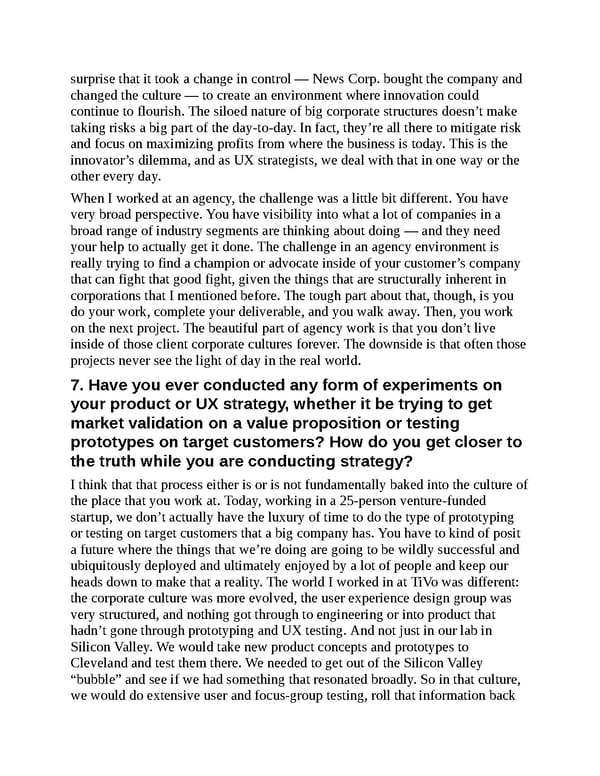surprise that it took a change in control — News Corp. bought the company and changed the culture — to create an environment where innovation could continue to flourish. The siloed nature of big corporate structures doesn’t make taking risks a big part of the day-to-day. In fact, they’re all there to mitigate risk and focus on maximizing profits from where the business is today. This is the innovator’s dilemma, and as UX strategists, we deal with that in one way or the other every day. When I worked at an agency, the challenge was a little bit different. You have very broad perspective. You have visibility into what a lot of companies in a broad range of industry segments are thinking about doing — and they need your help to actually get it done. The challenge in an agency environment is really trying to find a champion or advocate inside of your customer’s company that can fight that good fight, given the things that are structurally inherent in corporations that I mentioned before. The tough part about that, though, is you do your work, complete your deliverable, and you walk away. Then, you work on the next project. The beautiful part of agency work is that you don’t live inside of those client corporate cultures forever. The downside is that often those projects never see the light of day in the real world. 7. Have you ever conducted any form of experiments on your product or UX strategy, whether it be trying to get market validation on a value proposition or testing prototypes on target customers? How do you get closer to the truth while you are conducting strategy? I think that that process either is or is not fundamentally baked into the culture of the place that you work at. Today, working in a 25-person venture-funded startup, we don’t actually have the luxury of time to do the type of prototyping or testing on target customers that a big company has. You have to kind of posit a future where the things that we’re doing are going to be wildly successful and ubiquitously deployed and ultimately enjoyed by a lot of people and keep our heads down to make that a reality. The world I worked in at TiVo was different: the corporate culture was more evolved, the user experience design group was very structured, and nothing got through to engineering or into product that hadn’t gone through prototyping and UX testing. And not just in our lab in Silicon Valley. We would take new product concepts and prototypes to Cleveland and test them there. We needed to get out of the Silicon Valley “bubble” and see if we had something that resonated broadly. So in that culture, we would do extensive user and focus-group testing, roll that information back
 UX Strategy: How to Devise Innovative Digital Products that People Want Page 317 Page 319
UX Strategy: How to Devise Innovative Digital Products that People Want Page 317 Page 319